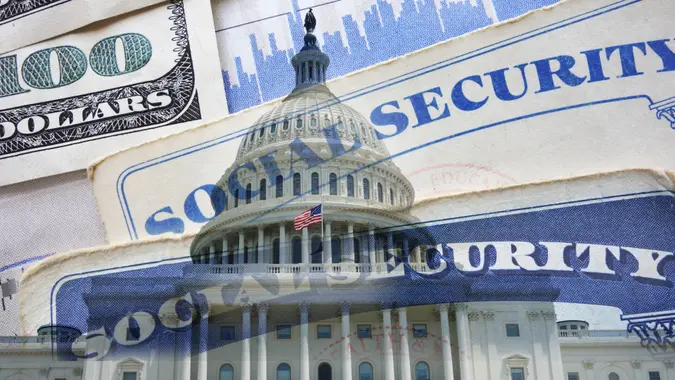How Much Would You Need To Save for Retirement If Social Security Ends

Commitment to Our Readers
GOBankingRates' editorial team is committed to bringing you unbiased reviews and information. We use data-driven methodologies to evaluate financial products and services - our reviews and ratings are not influenced by advertisers. You can read more about our editorial guidelines and our products and services review methodology.

20 Years
Helping You Live Richer

Reviewed
by Experts

Trusted by
Millions of Readers
It’s no secret that Social Security is struggling, and if changes aren’t made to rectify the problems, retirees will only receive 79% of their benefits beginning in 2033, according to the Social Security Administration (SSA).
To make matters worse, there’s widespread confusion about the current state of the program as Elon Musk and his team at the Department of Government Efficiency (DOGE) comb through data looking for fraud and cutting expenses.
Over 72.5 million people receive a Social Security check every month, per the SSA, and many who rely solely on the program are worried over new policies and potential staff cuts, which could cause a disruption in benefit payments, CNN reported.
Despite President Donald Trump’s assurances that he will protect Social Security, people are distressed about the situation. According to a new Gallup poll, 52% of Americans are worried a “great deal.”
In addition, younger Americans are doubtful that the system will be intact when it’s their time to retire, per Newsweek, and can envision a time where Social Security no longer exists.
If Social Security ends or benefits are reduced, financial experts say Americans would need to “double or triple” their savings.
Next, find out how much you need to save for retirement in every state, assuming you will have Social Security benefits.
Americans Need To Save at Least $2 Million Without Social Security
When deciding how much money to save for retirement, factors such as lifestyle, travel, grandkids, amount of debt and health need to be accounted for, and it’s more expensive than you might think.
“I’ve been working on this issue with my clients for years, and I’ll tell you — the numbers are sobering,” said money expert Andrew Lokenauth.
He explained, “Based on my calculations and experience, you’d need roughly $2 to $3 million saved to maintain a middle-class lifestyle without Social Security. That’s about double or triple what most financial advisors typically recommend with Social Security in place.”
Lokenauth, who manages retirement portfolios, shared how a recent client saved $1.2 million and thought she was set, but that wasn’t the case. “After running the numbers without Social Security, we realized she’d need at least another $800,000 to maintain her lifestyle. The math was brutal — that’s an extra $40,000 plus she needed to save each year.”
People Should Set Aside 25%-30% of Their Income
If Social Security benefits are reduced or end, Lokenauth suggests saving 25% to 30% of your income — way up from the standard 15% recommendation.
He pointed out the average Social Security benefit — $1,976 as of January 2025, according to the SSA — and explained, “Without that, you’re looking at needing an extra $400,000 to $500,000 just to generate that income on your own.”
He added, “I’m working with several 35-year-olds right now who’re increasing their monthly savings from $750 to $2,000 plus to compensate. And honestly — smart move. The earlier you start preparing for this possibility, the less painful the adjustment.”
How To Calculate Retirement Numbers
Planning for retirement can be tricky, because you never know what the future holds. Unexpected setbacks will happen, but one way to strategize is to use the “What’s my number” method, according to Eric Mangold, CWS, founder of Argosy Wealth Management.
To use this calculation, determine a number, like $1,000,000, and as soon as you have that amount saved, you can retire.
But it’s not that simple. Mangold said you have to “dig deeper” and understand how you came up with that figure and if you’re really accounting for all expenses during retirement — otherwise you could be “short-changing yourself.”
He explained, “If you are someone who earns $100,000 per year and believes that $1,000,000 is your magic retirement number, how did you come up with that? If we use this example, $1,000,000 could most likely comfortably generate $50,000 per year before taxes — assuming a 5% rate of return, because you don’t want to take too much risk in retirement.”
But if you’re making $100,000 per year before retirement, he said, “You just gave yourself a retirement pay cut. Remember, retirement isn’t about assets, it’s about income. Meaning it’s not how much you have, but what that amount can turn into for you to enjoy your retirement with confidence.”
The Best Way To Prepare
To plan for retirement without Social Security, Lokenauth advises a multi-pronged strategy.
- Maximize tax-advantaged accounts: 401(k) plans, IRAs, HSAs — Lokenauth said he’s putting away the full $22,500 in his 401(k), plus $7,500 in a backdoor Roth. “The tax savings make a huge difference.”
- Look into real estate options: “Several of my clients have built rental property portfolios generating $3,000 to $4,000 monthly — that’s basically replacing their potential Social Security income right there,” Lokenauth said.
- Focus on building multiple income streams: This is something “most advisors won’t tell you,” Lokenauth said. He added that combining dividend stocks, rental income and consulting work can replace Social Security benefits. “The key is starting these income streams well before retirement.”
- Cut expenses: Scaling down your monthly budget adds up. “I trimmed $1,500 from my monthly budget by relocating to a lower cost area, and it’s made a massive difference in my retirement projections,” Lokenauth explained.
While Mangold pointed out, “it’s highly unlikely Social Security will end totally,” many Americans are bracing for the worst and are starting to look into other revenue streams to prepare for retirement without the program so many count on.
Editor’s note on political coverage: GOBankingRates is nonpartisan and strives to cover all aspects of the economy objectively and present balanced reports on politically focused finance stories. You can find more coverage of this topic on GOBankingRates.com.
 Written by
Written by  Edited by
Edited by 























